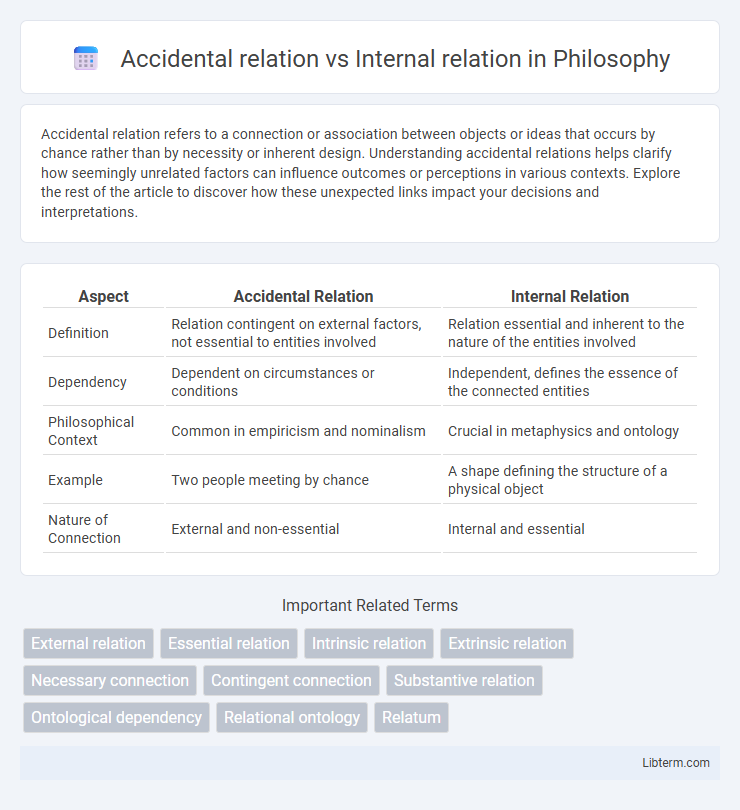Accidental relation refers to a connection or association between objects or ideas that occurs by chance rather than by necessity or inherent design. Understanding accidental relations helps clarify how seemingly unrelated factors can influence outcomes or perceptions in various contexts. Explore the rest of the article to discover how these unexpected links impact your decisions and interpretations.
Table of Comparison
| Aspect | Accidental Relation | Internal Relation |
|---|---|---|
| Definition | Relation contingent on external factors, not essential to entities involved | Relation essential and inherent to the nature of the entities involved |
| Dependency | Dependent on circumstances or conditions | Independent, defines the essence of the connected entities |
| Philosophical Context | Common in empiricism and nominalism | Crucial in metaphysics and ontology |
| Example | Two people meeting by chance | A shape defining the structure of a physical object |
| Nature of Connection | External and non-essential | Internal and essential |
Understanding Accidental Relations
Understanding accidental relations involves recognizing connections between entities or events that occur by chance rather than necessity, lacking inherent or essential links. These relations differ from internal relations, which are grounded in the essential nature or defining characteristics of the entities involved. Clarifying accidental relations enhances analysis in fields such as philosophy and logic by distinguishing contingent associations from fundamental interdependencies.
Defining Internal Relations
Internal relations are essential connections intrinsic to the nature or identity of the entities involved, meaning they cannot be altered without changing the entities themselves. These relations define the very properties and existence of objects, unlike accidental relations which are contingent and do not affect the essence of the entities. Understanding internal relations is crucial for analyzing how components within a system inherently depend on and determine each other's characteristics.
Key Differences between Accidental and Internal Relations
Accidental relations refer to associations between entities that do not affect their essential nature, whereas internal relations are fundamental connections that define the very identity of the entities involved. Accidental relations are contingent and can change without altering the essence, while internal relations are necessary and intrinsic, making them inseparable from the entities' existence. Understanding the key difference hinges on whether the relation impacts the essential characteristics (internal) or merely peripheral attributes (accidental) of the entities concerned.
Historical Perspectives on Relation Theory
Historical perspectives on relation theory distinguish accidental relations as contingent connections between entities, lacking inherent necessity, from internal relations, which are essential and define the nature of related entities. Philosophers like Aristotle emphasized internal relations as intrinsic to substance and identity, while later thinkers such as Hegel advanced the idea that all relations are internal, shaping reality itself. This evolution reflects ongoing debates on whether relational properties are fundamental or merely contingent in metaphysical frameworks.
Philosophical Roots of Accidental and Internal Relations
Accidental relations stem from empirical observations in Aristotelian philosophy, emphasizing contingent connections between entities that do not affect their essential nature. Internal relations, rooted in Hegelian dialectics and Leibnizian metaphysics, highlight necessary, intrinsic links that define the identity and essence of related entities. The debate over these relations explores whether connections are externally imposed or fundamentally constitutive of objects' reality.
Practical Examples of Accidental Relations
Accidental relations occur between entities that are not inherently connected but relate due to circumstances, such as a customer purchasing a product or two colleagues collaborating on a project. For example, the relation between a driver and a rented car is accidental since the driver is not the owner but temporarily interacts with the vehicle. Another instance is a guest attending a conference, where their relation to the event is incidental and does not imply permanent membership or ownership.
Practical Examples of Internal Relations
Internal relations exist when the connection between two entities is necessary and defines their very nature, such as the relationship between a triangle's three sides, which must sum to 180 degrees. An example is the dependence of a circle's radius on its circumference, where each point on the circumference maintains a fixed distance from the center. These relations are essential for understanding geometric properties, as changing one element directly alters the other, illustrating the intrinsic link in mathematical structures.
Implications for Metaphysics and Ontology
Accidental relations, characterized by contingent and non-essential connections between entities, shape the understanding of transient properties in metaphysics, challenging strict ontological classifications. Internal relations, defined by necessary and essential connections, underpin the coherence of entities' identities and support foundational ontological principles such as substance and essence. The distinction influences debates on object individuation, the nature of universals, and the metaphysical status of relational properties, fostering deeper inquiry into the structure of reality and the interconnectedness of beings.
Relevance of Relation Types in Modern Philosophy
Accidental relations describe contingent connections between entities arising from external factors, while internal relations denote necessary, essential links within the nature or identity of entities. Modern philosophy emphasizes internal relations for understanding the inherent structure and unity of concepts, contrasting with accidental relations that highlight empirical, non-essential associations. This distinction remains crucial in metaphysics and epistemology, influencing debates on objectivity, identity, and the coherence of systems of knowledge.
Debates and Criticisms Regarding Relation Distinctions
Debates surrounding accidental versus internal relations focus on whether relations are intrinsic to the nature of entities or contingent and variable. Critics argue that strict distinctions oversimplify complex ontological interdependencies, challenging the clarity and utility of categorizing relations as purely accidental or internal. Philosophical discussions emphasize the blurred boundaries and question if such dichotomies provide an accurate framework for understanding relational properties.
Accidental relation Infographic

 libterm.com
libterm.com